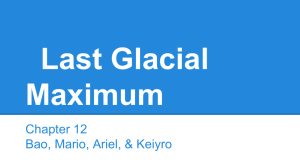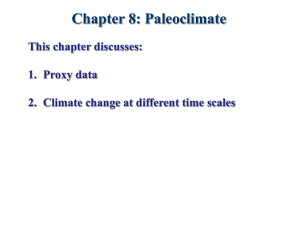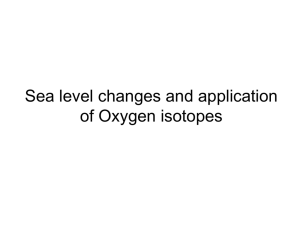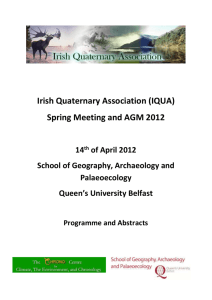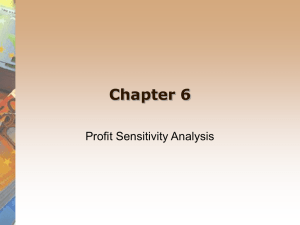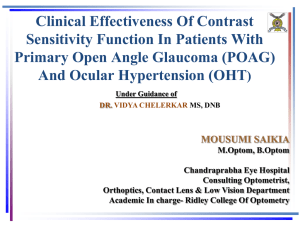Angela - rsmasclimate
advertisement
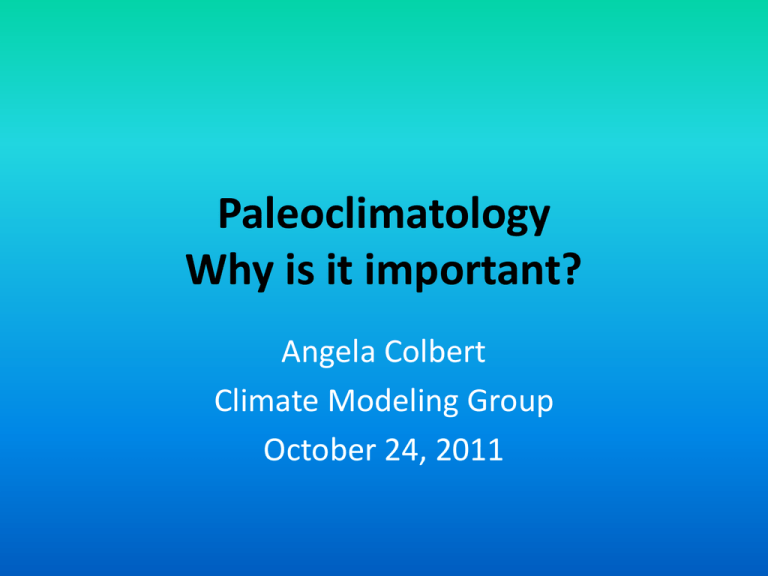
Paleoclimatology Why is it important? Angela Colbert Climate Modeling Group October 24, 2011 What is Paleoclimatology? • The study of past climates. – Use proxies to reconstruct temperature and other records – Use models to try to test theories to explain the proxy records • Proxy Examples – Sediment cores – lakes and oceans, use forams – Ice cores – very detailed for more “recent” history – Tree rings – annual ring made, very detailed Geological Time Scale Holocene Began ~ 10,000 years ago Last Glacial Maximum ~ 21,000 years ago Pleistocene – Last Glacial Period Pliocene – Last Non-Glacial Period http://www.knewance.com/storage/post-images/geologic_time.jpg What Can We Learn? • The importance and impact of changing levels of carbon dioxide • Past changes in ocean/atmospheric circulations • What has occurred naturally in the past and on what time scales • Climate sensitivity Interactions within Climate System Why Is It Important? • Rates of Climate Change – Tectonic, Orbital, Abrupt • Climate Sensitivity – What are the triggers for climate change? – How much natural variability is there? • Adaptation of ecosystems Rates of Climate Change Orbital Climate Change Abrupt Climate Change Amy will discuss this more later! Marine Isotope Stages http://www.geo.arizona.edu/palynology/geos462/06ocenzscor.html Climate Sensitivity • Lea (2004) – Comparing tropical SSTs to ice core records to isolate CO2 changes and determine climate sensitivity. • Hansen and Sato (2011) – A slightly more urgent approach… Lea (2004) Methodology for Climate Sensitivity • Linear Regression – Can be achieved by interpolating both records (SST and ice core) to a constant 2,000 yr sample interval. – Radiative effect of CO2 is first order, estimated climate forcing is calculated by: – With the effect of methane taken into account. • Slope: 1.4 + 0.1°C (W m-2)-1 • Intercept: 0.5 + 0.2°C – Positive due to warmer than present conditions at some previous interglacials • For 4 W m-2 = 4.4 5.6°C warming for doubling of CO2 Methodology for Climate Sensitivity • Multivariate Regression – Linear regression does not take into account other factors: ice volume, atmospheric dust – Derive relative weightings for each independent factor that can control tropical SST • Total greenhouse forcing, local insolation, NH insolation, two different records of ice volume, Vostok ice core dust – Find 1.3 + 0.1°C (W m-2)-1 slope Comparing Observations to Models • For tropical SST found sensitivity to be 4.4 5.6°C • 15 Climate models – 3.5°C (mean) with range of 2.0 – 5.1°C • Why different? – Smaller effect that glacial CO2 reduction has on tropical ocean temps in models (1-2°C) – Strong cooling effect on the Tropics from heat transport of ice sheets (possible factor?) The Paleoclimatic Approach (according to Lea) • Advantage – Provides series of equilibrium climate sensitivity experiments over a range of atmos. CO2 levels – No model assumptions • Disadvantage – Other climatic influences (size and distribution of glacial ice sheets, surface albedo, insolation changes, concomitant changes in ocean and atmos. circulation) could influence the past in a way that is not applicable to the future – Dust shows a comparable signal amplitude, but is limited spatially by sources Hansen and Sato (2011) • The formation of ice sheets resulted in global cooling. • Global temperatures were much warmer in the past than even today. • Shows the influence of plate tectonics. What They Argue • Paleoclimate data on climate change and climate sensitivity can yield accurate estimates for “the dangerous level of global warming” • The current agreement is the try to keep the warming below 2°C relative to pre-industrial times. • They argue that this would be “a disaster scenario for much of humanity” • A global warming of 2°C would result in heading back towards Pliocene-like conditions. Why They Argue That • Can use interglacial periods to assess what the threshold is before its dangerous – Peak Holocene temp occurred around 8,000 BP – MIS 5e and 11 were less than 1°C warmer than the peak Holocene, thus also less than 1°C warmer than in the year 2000. – Early Pliocene with sea levels 25 m higher than present also shows about a 1°C warming higher than present Climate Modeling • Otto-Bliesner et al. (2006) – Examined the IPCC CCSM3 Models – Last Glacial Maximum • Global cooling of 4.5°C with Tropical SST cooling of 1.7°C • Half of the cooling is from reduced CO2 levels (~50% of present-day) • Increase in Antarctic currents and deep water stratification and weaker North Atlantic – Mid-Holocene • Global cooling of less than 0.1°C • Regional and seasonal variations are more significant with weaker ENSO variability The Paleoclimatic Approach • Advantages – Can test theories on the limits and sensitivities of the climate system with boundary conditions that can be validated to a certain extent. – If models show something significant, it’s possible to examine cores to try to find evidence • Disadvantages – If it happened in the past, it does not mean the climate system will react the same way – Although improvements have been made, there are uncertainties for both models and the proxy records Resources • Larry Peterson – MGG 676 Paleoclimatology • Lea, D.W. (2004): The 100,000-Yr Cycle in Tropical SST, Greenhouse Forcing, and Climate Sensitivity. Journal of Climate, 17, 2170-2179. • Otto-Bliesner, B.L. and co-authors (2006): Last Glacial Maximum and Holocene Climate in CCSM3. Journal of Climate, 19, 2526-2544. • Hansen and Sato 2011: http://pubs.giss.nasa.gov/abs/ha05510d.html
